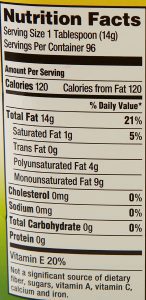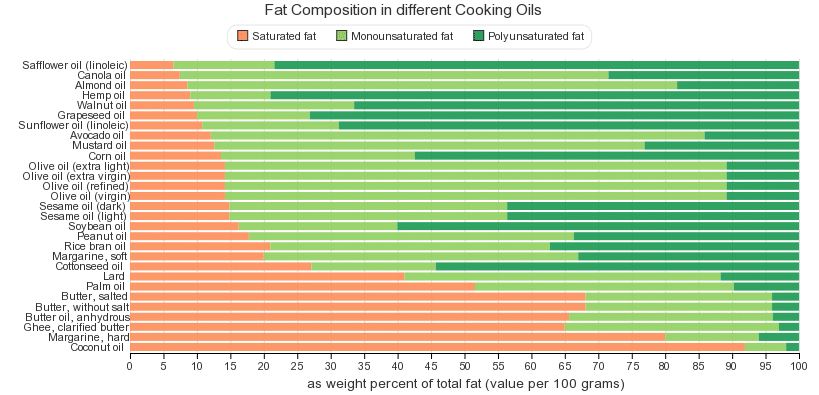
Vegetable oil and gout: read on to discover what vegetable oil is, what makes some types healthier than others, and whether or not they can safely be added into your gout diet.
Vegetable Oil and Gout
Before we go into the potential impact of vegetable oils on gout, let’s remind ourselves of what gout is…
Gout
Gout is caused by higher-than-normal levels of uric acid in the blood out of which tiny crystals of monosodium urate settle in the joints and surrounding tissue.
The body’s natural inflammatory response to these crystals gives rise to the typical symptoms of a gout attack:
- swollen, inflamed and stiff joint(s)
- skin over joint red and very warm to the touch
- excruciating pain
Studies have shown that diet can have an impact on the risk of these gout flare-ups: for example, high-purine, high-sugar diets containing a lot of acid-forming foods can increase uric acid levels and so raise the risk of recurrent gout flares.
On the other hand, low-purine, low-sugar diets containing more alkaline-forming foods can reduce that risk.
Now let’s take a look at what vegetable oil is…
Vegetable Oil
Vegetable oil is a generic term used to describe oils that have been extracted from plant sources: vegetables, nuts, seeds, fruits, and some cereal grains.
Popular vegetable oils include:
- rapeseed (incl. Canola)
- olive
- sunflower
- sesame
- coconut
- peanut
- corn
- palm
- grapeseed
- safflower
- soybean
The basic process for large-scale production of cooking oils is:
- cleaning
- pressing
- extraction (using low-boiling solvents)
- refining (including bleaching and deodorizing)
- packaging
Oils manufactured in this way are referred to as refined, bleached and deodorized (RBD) oils.
However, some vegetable oils, such as olive, sunflower, and flaxseed oils can also be produced using the “cold pressed” method which doesn’t use external heat or chemicals and has much less processing.
Cold pressed oils thus retain more of their natural properties including aroma, flavor, and vitamins, minerals, and antioxidants.
But extraction rates are lower, which is why cold pressed oils are generally more expensive than highly processed vegetable oils.
Are All Vegetable Oils Healthy?
The thing to look for is the ratio of the amounts of saturated and unsaturated fats (polyunsaturated and monounsaturated) each contains.
Generally speaking, healthier vegetable oils will contain a lot more unsaturated fats and much less unsaturated fats:
- Unsaturated fats have been linked to lower total cholesterol and a reduced risk of heart disease.
- Saturated fats have been associated with unhealthy cholesterol levels and cardiovascular disease.
So always inspect the nutrition label on the container. It could look something like this:

According to this label, 1 tablespoon (14 g) of the vegetable oil in this bottle contains:
- 1 g (7%) saturated fat
- 4 g (29%) polyunsaturated fat
- 9 g (64%) monounsaturated fat
So this particular cooking oil looks relatively healthy since 93% of its fat content is healthier unsaturated fat and 7% unhealthy saturated fat.
Most countries’ health governing bodies recommend that you replace saturated fat with healthier unsaturated fats as much as possible.
For example…
2015-2020 Dietary Guidelines for Americans
The 2015-2020 Dietary Guidelines for Americans recommend the following targets for healthy adults:
- Total fat: 20% to 35% of daily calories
- Saturated fat: less than 10% of daily calories
But what does that mean in reality and how can you use this data?
Let’s say you consume 2,000 calories per day on average:
- 20% of 2,000 = 400
- 35% of 2,000 = 700
- 10% of 2,000 = 200
So, according to the Guidelines, the caloric targets for a healthy adult on 2,000 calories per day are:
- Total fat: 400 to 700 calories per day
- Saturated fat: less than 200 calories per day
To convert calories to grams divide by 9 (since there are 9 calories in one gram of fat):
- 400/9 = 44
- 700/9 = 78
- 200/9 = 22
Thus, for a healthy adult on *2,000 calories per day, the gram equivalents are:
- Total fat: 44 to 78 grams per day
- Saturated fat: less than 22 grams per day
*Use your own daily calorie intake, then just follow the steps to get your gram equivalents.
So are vegetable oils safe in a gout diet?
Vegetable oils have negligible purines, zero sugar content and are largely neutral in terms of their alkalinity/acidity once metabolized. So, purely in those terms, vegetable oils are generally safe in a gout diet.
But, given that vegetable oil is essentially fat, should you even be consuming vegetable oil at all?
Saturated Fats and Artificial Trans Fats
Saturated fats and artificial trans fats (made by a process called “hydrogenation”) have been associated with raised risks of stroke, coronary heart disease, type 2 diabetes, and even cancers like breast cancer and colon cancer.
All vegetable oils contain saturated fat to varying degrees and many may also contain artificial trans fat (sometimes shown on the label as “hydrogenated” or “partially hydrogenated” oil), although these instances are decreasing as more and more countries ban artificial trans fats from manufactured foods.
[Note: Low levels of trans fatty acids are naturally present in some foods, like dairy produce and meat. But the chemical structure of naturally-occurring trans fats is different to artificial ones. Unfortunately there’s insufficient evidence to determine whether or not natural trans fats are less risky than artificial ones although, according to Harvard Health Publishing, “…there are other reasons to believe that natural trans fat is less harmful than the artificial version.”]
But, of course, that’s not the whole story…
Effect of High Temperatures on Vegetable Oils
During the cooking/frying process, thermo-oxidative changes occur that can degrade some of an oil’s components. For example, otherwise healthy polyunsaturated fats break down and turn into unhealthy trans fats.
In addition, at high temperatures, oils rich in polyunsaturated fatty acids produce very high levels of toxic oxidative products, such as “aldehydes” and “lipid peroxides,” that have been linked to an increased risk of heart disease and cancer.
And the oil degrades even further with each subsequent use making this practice particularly harmful.
So, although the fat profile on the label might look healthy enough, it’s what happens to a particular oil at high temperatures that’s important.
For cooking, look for vegetable oils with a higher monounsaturated fat content since they are more stable at high temperatures than those with a higher polyunsaturated fat content. Polyunsaturated oils contain short-chain fatty acids that break up more easily when heated…
Fat Composition in Different Cooking Oils

Image: Fat Composition in Different Cooking Oils, ChartsBin.com
Use cold pressed, unhydrogenated vegetable oils wherever possible, especially extra-virgin olive oil which contains much of its original antioxidants and anti-inflammatory properties and is a common ingredient in the heart-healthy “Mediterranean diet”“.
And, contrary to popular belief, you can use extra-virgin olive oil, not just on salads, marinades and in dressings, but in almost all cooking since it’s pretty stable at high temperatures because of its very high monounsaturated content and low polyunsaturated fat content. And it has high levels of phenolic (antioxidant) compounds that also help to protect against thermo-oxidative degradation.
The smoke point of extra-virgin olive oil is 410 deg F (210 deg C) which is more than enough for things like roasting, sautéing, pan-frying and stir-frying, which are generally done between 250 and 400 deg F (121 and 204 deg C).
The following video gives a pretty good insight into extra virgin olive oil at high heat…
How safe is olive oil at high heat?
Then again, instead of frying in vegetable oil, why not cook healthily by steaming, boiling, grilling, microwaving, or baking your gout-safe foods whenever possible?



